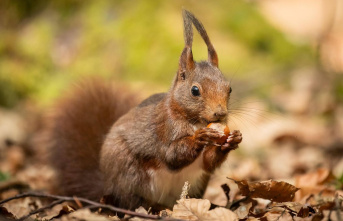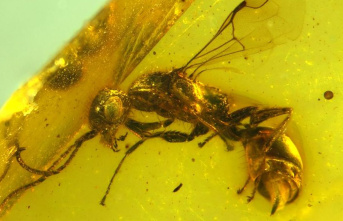Whether the rainforest in the Amazon basin is protected or the lapwing in European fields: most nature conservation measures worldwide actually have a positive effect on biodiversity. However, the efforts so far are far from enough. This is the result of a review study that has just been published in the renowned journal “Science”. To do this, an international team of researchers led by biologist Penny Langhammer from Arizona State University evaluated more than 180 studies from 42 countries.
The comprehensive and at the same time global approach of the analysis is – amazingly – almost a novelty: Most other studies to date have examined how specific nature conservation measures affect regional animal and plant communities, for example on some moors, forests, a coral reef or an agricultural landscape. This is because field work in ecosystems, collecting and identifying animals and plants – and doing this over years – is extremely time-consuming.
In order to realistically assess the benefits of nature conservation, studies are needed that compare what happens when one area is actively protected and the destruction in another area is simply allowed to continue. One could also say: placebo studies for nature, in which a potentially effective "treatment" is compared with ineffective inaction.
For the new study, the researchers analyzed many different types of nature conservation for the first time: classic protected areas as well as political measures to prevent the devastation of nature, as well as the renaturation of areas and bodies of water that have already been destroyed, the careful use of animals through controlled hunting or sustainable use Management through agriculture. The researchers also examined the containment of pollutants, the fight against invasive species and adaptation to climate change.
The result was a huge data package that is now intended to close many gaps in knowledge. Which is sorely needed right now, because the biodiversity crisis is considered one of the key global problems. The world's governments are currently looking for solutions to achieve internationally agreed goals for protecting biodiversity. 121 billion US dollars are already being spent on nature conservation every year worldwide - while at the same time animal and plant species are seemingly inexorably becoming extinct.
“After the international community committed to preserving biodiversity at the Montreal Conference in December 2022, governments need robust data on the effectiveness of individual measures, ideally in comparison with each other and with a global perspective,” says Matthias Glaubrecht, Professor of Biodiversity Animals at the University of Hamburg. "This is now provided by the current study - as far as I know, for the first time so comprehensively, evaluating around 180 individual studies and looking back over the past 100 years." Glaubrecht himself was not involved in the large-scale analysis, but just classified it in a press briefing together with other independent scientists for the German Science Media Center in Cologne.
According to the new Science publication, two-thirds of the conservation approaches considered had a significantly more positive impact on biodiversity than the approach of simply using the ecosystems as usual. Around 20 percent at least had a protective effect and noticeably slowed down the decline in biodiversity, such as the large protected areas in the Amazon and the areas there that are managed by indigenous people. 45 percent of the nature conservation activities examined were even able to increase biodiversity in an area: Among the most effective measures are conservation efforts in agriculture, which are often unpopular with farmers - because they supposedly rob them of land: For example, breeding islands in fields increase - Protected "holes" in which no grain is sown - proven to increase the number of birds nesting on the ground. In Germany, this includes the lapwing, which is now so massively threatened that it was even named “Bird of the Year” in 2024.
However, more than a fifth of the nature conservation measures turned out to be counterproductive: one of the most pointless measures was the attempt to remove invasive algae from coral reefs off India's coast - which actually had the opposite effect of causing the unwanted aquatic plants to spread even further. Native algae and corals, on the other hand, are wasting away.
In ten percent of the nature conservation interventions researched, the researchers were able to demonstrate positive effects - but "letting things go as usual" performed even better: for example, in marine protected areas off Australia, the rare seahorses increased, but unfortunately also seahorse-eating predatory fish and octopuses, so Fishing the marine areas performed better in this case.
The bottom line, however, is that the new study provides encouraging evidence: “We see that measures to protect biodiversity work in most cases,” conclude the authors. "Our meta-analysis shows that the bottom line effect of nature conservation is positive and significant." And even the unsuccessful removal of algae off India seems - literally - an outlier: the fight against invasive animal and plant species is one of the most effective measures of all to save endangered animals and plants - especially on islands whose biodiversity is caused by introduced rats or cats was threatened. The fight against the destruction of land, the sustainable use of ecosystems and – quite classically: the designation of protected areas – also proved to be very effective.
The new large-scale study does not answer some questions: So far, there is little data available on how well climate protection measures or reducing pollutants in the environment protect certain animal and plant species. The continent of Africa and many island states have so far received comparatively little research when it comes to biodiversity.
But the main problem in global nature conservation is not the data situation, but - according to the new research work - the implementation: It can be considered proven that many measures are effective on a smaller, local scale. But it is not enough to stop the global extinction of species, and certainly not to reverse the negative trend.
Independent experts also see it that way and are calling for more commitment from politicians: "The worst conclusion that decision-makers or society should draw from this work would be: 'It will be okay, the measures are working.' This would depend on the extent of the actual "Distract existing problems and potentially divert urgently needed increased resources from nature conservation," says Sven Bacher, head of the Applied Ecology working group at the University of Freiburg in Switzerland. Bacher is also one of the experts who recently evaluated the current study for the “Science Media Center”. “We need nature conservation on a much larger scale,” Bacher continued. "Or better yet: we should prevent the five global drivers of loss - invasive species, climate change, land and sea use changes, pollution, overexploitation - from further reducing biodiversity. So more prevention so that less restoration, adaptation or control is necessary. "
The science study team provides concrete figures: If conservation measures were to be scaled up on a global scale to do much more than just save the most valuable areas and the rarest species, it could cost up to 500 billion US dollars a year. However, the researchers say that this would be more than worthwhile as an investment - given the immense benefits of rich biodiversity. There are many examples here, from the pollination of crops to water storage in forests to the still unexplored potential of many plant species for medicinal purposes.












